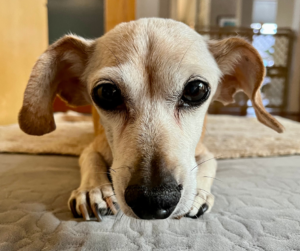Michael Baugh CDBC CPDT-KSA
Mindfulness is something of a buzz word these days, even in dog training. At its core, mindfulness is awareness in the present moment. In deep meditation it is awareness of awareness itself. For us, though, let’s think of mindfulness as awareness of our dog right here and right now. Pause for a moment and try this.
Take a breath. Our focus is on our dog. However, it’s smart to start by relaxing and settling our minds. Taking a few breaths and noticing those first can help. They don’t have to be deep breaths, though the can be. Just breathe normally.
 Observe without judgment. Then, watch your dog. You can sit, but you don’t have to. Your dog can do anything. Notice what it is your dog is doing. That’s all. Avoid the natural inclination to attach any story to the behavior. No commentary. No judgement. My dog is looking at me. My dog is lying down. My dog is sniffing this or that. My dog is chewing this or that. This is so simple that it might seem silly. I get it. The funny thing is we hardly ever do this – really notice what are dogs are actually doing.
Observe without judgment. Then, watch your dog. You can sit, but you don’t have to. Your dog can do anything. Notice what it is your dog is doing. That’s all. Avoid the natural inclination to attach any story to the behavior. No commentary. No judgement. My dog is looking at me. My dog is lying down. My dog is sniffing this or that. My dog is chewing this or that. This is so simple that it might seem silly. I get it. The funny thing is we hardly ever do this – really notice what are dogs are actually doing.
Notice your own thoughts. This is where real mindfulness comes in. What are you thinking (and feeling) about what you are observing? Don’t judge. There are no right thoughts or wrong thoughts.
Let them go. Our thoughts and feelings about our dogs (about anything) tend to just show up. Sometimes it may seem like they slip into our minds out of nowhere. We get hooked by them and before you know it we are daydreaming (or obsessing). But, just as quickly as thoughts and feelings arise, they can also fade away. Try this. While you are watching your dog, notice the thoughts that come to mind. Hmm, I don’t like when he does that. He’s kind of making me anxious. or Oh, that’s cute. It doesn’t matter what it is. Simply notice the thought, just like you were watching your dog – relaxed and without judgement. Then, let it go.
Stay here. We tend to get caught up in the stories we create about our dogs. We presume what they must be thinking or feeling when, really, all we can know for sure is what they are doing. The stories distract us from what is really happening right here right now. We get swept into ruminating about the past or worrying about the future. All this distracts us from what is actually occurring in front of us now. Let the stories go. Stay here.
Now teach. Here’s the dog training part. The stories we tell ourselves and our own obsessive thoughts and feelings actually get in the way of helping our dogs. We can’t help them with their behavior if we are still fumbling with our own internal rambling. Observing our dogs gives us good information about what we want to work on. Quieting our own minds, even a little bit, sets us up to actually do the work.
All this might sound hard. It’s not. It might also seem senseless and unnecessary. I don’t think so. This method has helped me help thousands of families over the years. It’s the reason some people say I’m so calm (I’m not always calm – haha). Most importantly, it’s effective and simple – two things I think we all are looking for when it comes to dog training.
Michael Baugh teaches dog training in Houston Texas. He specializes in aggressive dog training.
